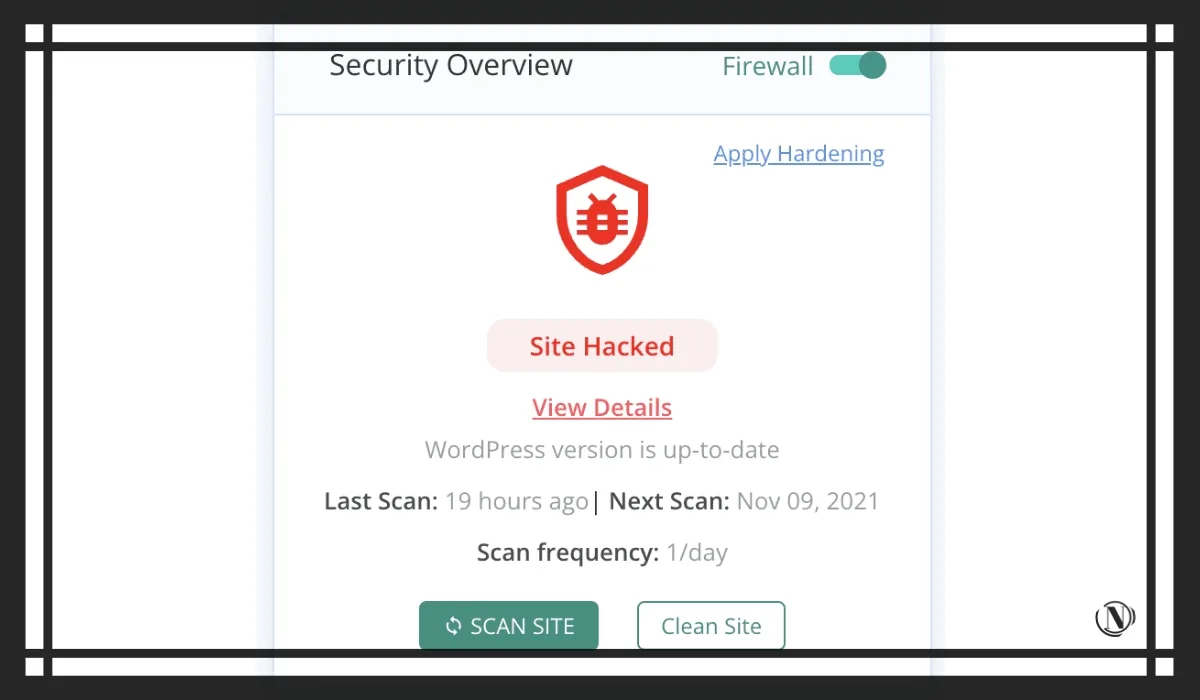XSS attacks on WordPress: how to prevent them
 WordPress XSS Attacks or cross site scripting are the most common hacking mechanisms on the Internet today. They target your website visitors, wanting to steal their information. The worst part XSS attacks is that in order to do this, attackers use vulnerabilities in your WordPress website.
WordPress XSS Attacks or cross site scripting are the most common hacking mechanisms on the Internet today. They target your website visitors, wanting to steal their information. The worst part XSS attacks is that in order to do this, attackers use vulnerabilities in your WordPress website.
At first glance, XSS attacks don't seem very dangerous, especially when compared to other attacks like brute force or SQL injection. The cross-site scripting attack is carried out using JavaScript, and JavaScript is tightly controlled by the browser. Thus, it must have very limited access to the rest of the person's device. This is true, but it does not mean that there will be less danger. The WordPress XSS attack is a gateway to more destructive attacks and should be considered dangerous in its own right.
The content of the article:
- What is a WordPress XSS Attack
- Consequences of an XSS attack in WordPress
- How to Check if Your Site Has a WordPress XSS Vulnerability
- What to do if an XSS exploit attack brings malware to your site
- WordPress XSS Protection: 5 Ways to Prevent XSS Attacks
- How a WordPress XSS attack works
- Types of attacks using cross-site scripting
- conclusions
What is a WordPress XSS Attack
A cross-site scripting attack, or WordPress XSS for short, is when an attacker injects malicious JavaScript code into a website. When a visitor lands on this website, their browser executes the code. The malicious script is assumed to have come from a trusted source, which in this case is a website.
XSS attacks are possible because the site has a cross-site scripting vulnerability. The vulnerability is when a website uses external inputs in the output it generates without prior validation.
Consequences of an XSS attack in WordPress
The main targets of XSS attacks are your website visitors, or rather their information. Therefore, if the XSS attack is successful, the malicious script will have access to all information about the browser of the visitor to which your site has access. This includes cookies, session information, etc.
A lot can go wrong at this stage:
- The hacker gains access to the visitor's personal data and can take over his account on your site. From now on, the situation can quickly escalate.
- A hacker can impersonate a visitor because he has access to his data.
- The malicious script may redirect the visitor to another website or show them content that is not related to the original site they visited. The malicious script can even change the way the page is displayed in the browser.
- In very severe cases, the attacker can attack the visitor using social engineering such as phishing.
For a website, the impact of an XSS attack on WordPress can vary. WordPress websites can run into serious problems when they store users' personal data that can be stolen by hackers. If the user in question is an administrator or someone with sufficient privileges, a hacker can impersonate them and completely compromise the website.
How to Check if Your Site Has a WordPress XSS Vulnerability
XSS vulnerabilities exist in the code – either in the core WordPress code, or in the code of plugins and themes. Unless you're developing native code for your website, it's unlikely that you're dealing with user input directly, and so figuring out how to make it secure is out of your purview.
The only real way to check if your WordPress website is susceptible to XSS attacks is to use a scanner such as XSS Hunter, or use the services of a penetration tester.
However, this does not mean that you cannot protect your site visitors from potential XSS vulnerabilities on your site. Installing a WordPress firewall prevents attacks and goes a long way in protecting your visitors.
In addition, you can keep track of installed plugins and themes. If any of them expose XSS vulnerabilities, be sure to update them as soon as possible.
What to do if an XSS exploit attack brings malware to your site
Site visitors are ostensibly the targets of an XSS attack, but this group can also include site administrators. If your website has a cross site scripting vulnerability and the administrator account has been compromised, you should assume that your website's security has also been compromised.
In addition to stealing data from individuals, XSS attacks are also used to continue other attacks such as remote code execution.
So while a WordPress XSS attack doesn't immediately turn into malware, it's best to play it safe. If your site has malware, get rid of it immediately.
Scan your website
The only way to find out if your site actually has malware is to scan it. This can be done in several ways, but not all of them are equally effective.

I recommend that you take deep scan your website with a security scannerto find the smallest traces of malware on your website or database. This is the ultimate way to determine if your site has malware.
WordPress XSS Protection: 5 Ways to Prevent XSS Attacks
WordPress cross-site scripting vulnerabilities are found in the code, and there is little that a WordPress administrator can do to fix these vulnerabilities. However, there are definitely things you can do to protect your site visitors from XSS attacks.

1. Install a web application firewall
Firewalls — the best defense against ever-changing threats. Firewalls have special rules that look for requests that may contain suspicious text commonly found in XSS attacks.
2. Update all your plugins and themes
WordPress security vulnerabilities are constantly being discovered in plugins and themes. Responsible developers release security patches for them so that sites are not at risk. As soon as patches are available, people who discover vulnerabilities publish news. Therefore, websites that have not updated their plugins and themes become a target for hackers.
3. Install a Good WordPress Security Plugin
XSS attacks are really dangerous for website owners if the target user is an administrator. XSS can be used to obtain login credentials and then infect a site with malware. A good security plugin will help you keep track of unusual user activity, and a daily scan will quickly identify any malware.
4. Implement WordPress Security
Hardening WordPress is a series of steps you can take to make your WordPress site more secure overall. Of these, I especially recommend two-factor authentication. The biggest danger of XSS attacks is credential and identity theft, so two-factor authentication goes a long way in preventing stolen credentials from being used to access your site. Other hardening steps, such as disabling XML-RPC, would also be nice to implement.
5. Follow the Least Privileged Users Policy
If a user account is compromised due to an XSS attack, the potential damage they can cause is limited by their permissions on the website.
If you are a WordPress developer, always sanitize user input. Your website should check every input for malicious code, especially before it is displayed as output.
How a WordPress XSS attack works
XSS attacks work in two parts: injection and consequences.
First, a hacker injects malicious JavaScript into a vulnerable website. This can be done in several ways, which we will discuss in the next section. Then, when the visitor lands on the site, the browser executes the malicious JavaScript because it considers it to be part of the website.
The consequence of this is that the hacker now has access to all visitor data that is visible to the website. This may include their cookies, session information, and login details. This information can be used to launch other attacks such as phishing or cookie theft.
What does this have to do with your WordPress site?
At this point, it looks like the problem lies with the visitor and their browser. However, this is not accurate. The browser will not execute malicious code unless it considers it part of a trusted website. If the visitor is on your site, the trusted site belongs to you.
The XSS attack works because the website must have an XSS vulnerability. This means that it should accept user input without any input validation or validation. Only then does a WordPress XSS exploit allow an attacker to easily inject JavaScript into a website.
Let's look at an example:
In a WordPress blog, the admin wants to allow readers to leave comments under articles. The administrator installs a plugin to manage the specified comments.
When a reader wants to leave a comment, they enter it in the text box provided by the plugin. Anyone can type their comment and submit it to the site's database. So far, so good.
The problem comes when someone not very good types a comment but adds a script to it. The input will be something like: “This cake recipe is excellent! » . Script tags contain JavaScript code that is malicious and designed to interact with other website visitors.
The plugin does not check comments for these scripts, assuming they are text. And then saves it as is in the database. This is an XSS vulnerability.
Now another visitor visits the blog page and their browser loads the page and the comments. The website's database has saved all the comments and sends them to the browser so that the new visitor can see them. But because there is JavaScript in one of the comments, the browser thinks that this piece of code needs to be executed. And it does this by assuming the code is part of a website. But it's not. The website thought the code was text and saved it as such. The browser sees the script and executes it. This is how an XSS attack works.
If the plugin checked comments for malicious code before saving them to the database, the site would not have an XSS vulnerability. The browser will not receive the JavaScript code and the visitor's data will be safe.
Types of attacks using cross-site scripting
Cross-site scripting attacks are classified based on where the code is stored and executed. There are 3 main types of attacks: stored or persistent, reflected and DOM. However, they are not mutually exclusive. XSS attacks can be a combination of these types. However, it is useful to understand these types and see how they intersect with each other.
Saved XSS:
In the comment example from the previous section, the comment was sent to the website's database and stored there. Then, when the visitor arrives, it is sent to their browser. Since the code is stored in the database, it will be sent to all visitors. That's why it's called stored or persistent XSS.
Reflected XSS:
Reflected XSS attacks are a little tricky to understand because they involve the visitor sending malicious code to the website, albeit unwittingly. The attacker sends a link to your site to your visitors, usually via email or through a neutral website. However, the link contains malicious code, so when a visitor clicks on it, they send that code to your site.
If your website has an XSS vulnerability, it means that your website is not validating user input for malicious code. So when your website sends a response back to the visitor's browser, it also includes malicious code. The visitor's browser now thinks the code is part of your site and executes it. Thus, the attacker gains access to information about the visitor.
In both saved and reflected XSS attacks, a website is involved in the attack. Malicious code actually hits the web server or database and is sent back to the visitor. The only difference is whether the attacker sends it to the site or the visitor himself.
DOM based XSS:
In the case of DOM-based XSS, no code is sent to the website at all. Malicious code can be sent to the visitor, as in a reflected XSS attack, but instead of being sent to the site at all, it is executed directly by the browser. It may not seem like a vulnerability on the website at all, but it is. The malicious script is not sent to the site, but remains in the visitor's browser. The visitor's browser sends a request to the site's server. The server response uses user input that is already in the browser. Which in this case is malicious code.
That being said, the types of XSS attacks shouldn't worry you, because there's not much you can do to fix cross-site scripting vulnerabilities. There is no way to test plugins and themes to see if they have these vulnerabilities before they are discovered. However, as soon as they are discovered, you should immediately update them.
You can protect your website visitors from cross-site attacks by installing a firewall. This is the only real protection against malicious code.
conclusions
WordPress XSS attack is very common and they target website visitors to steal data. As a responsible website administrator, you want to protect your visitors from harm. Installing a WordPress firewall will help you with this.
FAQ
Is WordPress Vulnerable to XSS?
Yes, WordPress is vulnerable to XSS attacks. In addition to plugins and themes, many XSS vulnerabilities have been found in core WordPress files. Responsible developers quickly fix these WordPress XSS vulnerabilities and update their software so that it cannot be exploited by hackers.
What does cross-site scripting mean?
Cross Site Scripting (XSS) Cross-site scripting (XSS) is a cyberattack that uses malicious scripts in your web browser to hijack browser session cookies and steal highly sensitive data. When used effectively, cross-site scripting can steal passwords and financial information. WordPress XSS hacks are very difficult to protect unless you use a powerful firewall.
How to prevent XSS in WordPress?
The easiest way to protect against XSS attacks in WordPress is to install a firewall that can effectively block malicious traffic. For WordPress, we also recommend protecting your site from common hacks.
Reading this article:
- How to protect WordPress files and directories with .htaccess?
- How to fix wp-feed.php and wp-tmp.php malware in WordPress?
Thanks for reading: SEO HELPER | NICOLA.TOP









